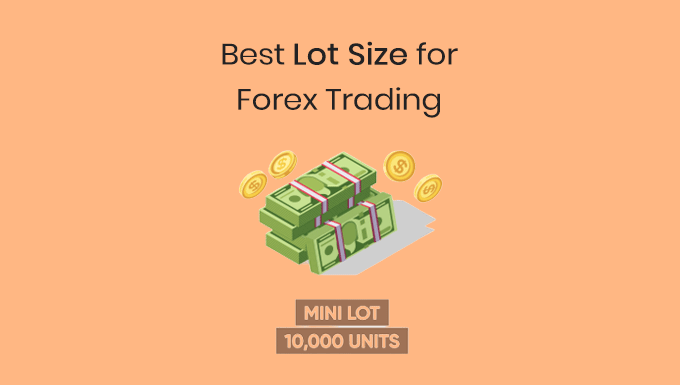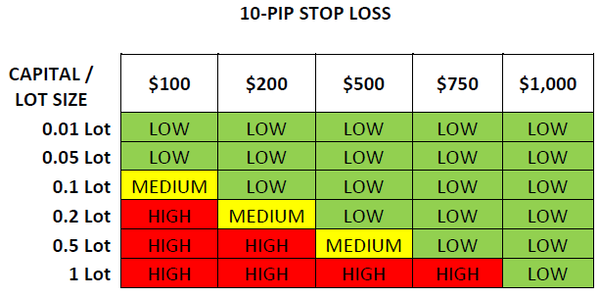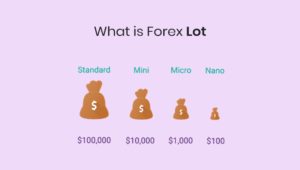Using the best lot size for forex trading can be the difference between success and significant losses. Lot size, which determines how many currency units a trader deals with in a transaction, isn’t a one-size-fits-all idea. Various factors, from account size to personal risk tolerance, play a role in determining the best fit for each trader. This detailed guide provides specifics on lot sizing in forex, providing valuable insights for both new and experienced traders.
Table of Contents
• Factors Influencing the Ideal Lot Size
• Best Lot Size for Forex Based on Account Size
• The Relationship between Lot Size, Leverage, and Risk
• Benefits of Using Optimal Lot Sizes in Trading
• Common Mistakes Traders Make with Lot Sizing
• How Technology and Tools Can Help Determine the Best Lot Size
• Conclusion
• FAQs
Understanding the Basics of Lot Sizes in Forex
In forex trading, the term ‘lot‘ refers to the size of the trade. A lot size essentially determines the number of currency units a trader will buy or sell in a transaction. The three main types of lot sizes include:
Micro Lots
Consisting of 1,000 units of the base currency, micro lots cater to beginners and those looking to minimize risk.
Mini Lots
These encompass 10,000 units and are more suitable for traders who have a bit more experience and capital at their disposal.
Standard Lots
At 100,000 units, standard lots are reserved for seasoned traders with a substantial capital base.
By understanding the differences between these lot sizes, traders can better gauge which is suitable for their trading strategy and risk tolerance.
Factors Influencing the Ideal Lot Size
Choosing the right lot size is paramount for successful forex trading. Several factors come into play when making this decision:
Capital Size
Naturally, the more capital you have, the larger lot size you can handle. However, it’s not just about having the funds but also about managing them wisely.
Risk Tolerance
Each trader has a unique risk profile. Some might be comfortable risking 5% of their capital on a single trade, while others might prefer to risk only 1%.
Trading Strategy
Different trading strategies might require varying lot sizes. For instance, a scalping strategy might benefit from smaller lots, whereas a longer-term strategy might employ larger ones.
Market Conditions
Volatile markets might warrant more caution and thus a reduced lot size, whereas more stable conditions could allow for an increase.
Understanding the interplay of these factors is crucial to determining the ideal lot size tailored to individual circumstances.
Best Lot Size for Forex Based on Account Size: $100, $1000, and $5000
Determining the right lot size becomes very important when the size of the trading account varies. Here’s a more detailed guide to understanding the ideal lot size for different account balances:
$100 Account
With a smaller account like $100, risk management is paramount.
Lot Size: Micro Lot (1,000 units)
Example: If trading a currency pair where the pip value is $0.10, a 10-pip loss would equate to a $1 loss, or 1% of the account. Using micro lots allows for flexibility with stop-loss placement and reduces the risk per trade, keeping the exposure limited.
$1000 Account
For medium-sized accounts, there’s a bit more flexibility, but caution is still essential.
Lot Size: Micro Lot (1,000 units) to Mini Lot (10,000 units)
Example: Using a mini lot on a currency pair with a pip value of $1, a 10-pip loss would equate to a $10 loss, or 1% of the account. However, if the trader’s risk appetite and strategy align, using mini lots could be an option, but it’s vital to ensure that protective measures, like stop-loss orders, are in place.
$5000 Account
A $5000 account offers even more flexibility.
Lot Size: Mini Lot (10,000 units) to Standard Lot (100,000 units)
Example: If trading a currency pair with a pip value of $10 using a standard lot, a 10-pip loss would translate to a $100 loss, or 2% of the account. However, while this account size offers the capability to trade standard lots, it’s essential to be cautious and ensure that risk remains proportional to the account balance.
The Relationship between Lot Size, Leverage, and Risk
Lot size doesn’t operate in isolation in the world of forex. It has a direct relationship with both leverage and risk. Here’s how:
Leverage
Often expressed as a ratio, leverage allows traders to control a larger position with a relatively small amount of capital. While this can amplify profits, it can also magnify losses. A larger lot size with high leverage can result in significant profits or losses on small price movements.
Risk
Risk in forex refers to the potential loss that a trader might face in a trade. The risk is directly proportional to the lot size. The larger the lot size, the higher the risk, and vice versa.
By balancing lot size with the right amount of leverage, traders can control their risk and maximize potential returns. But always remember, while high leverage can lead to high returns, it can also result in significant losses.
Benefits of Using Optimal Lot Sizes in Trading
An optimal lot size does more than just manage risk; it offers several benefits:
Consistency in Trading
By using a consistent lot size tailored to one’s risk profile, traders can achieve more predictable outcomes and manage their trades better.
Better Capital Management
Optimal lot sizing ensures that traders don’t overextend themselves, preserving their capital for future opportunities.
Enhanced Psychological Comfort
Knowing that they are not overexposed, traders can make decisions with a clearer mind, free from the fear of substantial losses.
Improved Profit Potential
While this may sound counterintuitive, using the right lot size can lead to better profit potential. By managing risk and preserving capital, traders can take advantage of more trading opportunities.
Tailoring lot sizes to individual needs and circumstances is essential for both risk management and capitalizing on forex opportunities.
Common Mistakes Traders Make with Lot Sizing
Even seasoned traders can sometimes err when it comes to lot sizing. Some common mistakes include:
Overleveraging
Being overambitious can lead traders to use more leverage than their capital or risk tolerance allows. This can result in significant losses.
Not Adjusting Lot Size to Market Conditions
Sticking to a single lot size regardless of market volatility is a recipe for disaster. Traders should adjust their lot size according to market conditions.
Ignoring Stop-Loss Orders
Failing to set a stop-loss or setting it too far can result in higher losses, especially if a trader has chosen a larger lot size.
Being Influenced by Emotions
Making decisions based on emotions rather than a well-thought-out strategy can lead traders to choose inappropriate lot sizes.
Avoiding these mistakes and being mindful of one’s strategy and risk tolerance is key to successful lot sizing in forex.
How Technology and Tools Can Help Determine the Best Lot Size
In the age of technology, traders don’t have to rely solely on intuition or manual calculations. Several tools and software solutions can assist in determining the best lot size:
Forex Calculators
These handy tools allow traders to input various parameters, such as account size, risk tolerance, and stop-loss, to compute the ideal lot size.
Trading Platforms
Many modern trading platforms come with built-in tools and analytics to assist traders in choosing the right lot size based on their strategy and market conditions.
AI and Machine Learning
Emerging technologies like AI can analyze vast amounts of data to give traders insights and suggestions about the best lot sizes for specific scenarios.
Educational Platforms
Online courses, webinars, and tutorials often provide guidance on lot sizing, helping traders make informed decisions.
By leveraging these tools and technologies, traders can achieve a more scientific and data-driven approach to determining the best lot size for their trades.
Conclusion
Identifying the best lot size for forex is an ongoing journey, one that can significantly influence a trader’s profitability and risk profile. From understanding the basic concepts to leveraging advanced tools, a strategic approach to lot sizing can enhance trading consistency and capital preservation. As markets evolve and personal trading strategies undergo refinement, it’s essential to revisit and adjust lot sizes accordingly. Remember, while tools, guidelines, and tips can provide direction, the ultimate decision rests with the trader, emphasizing the importance of continuous education and informed decision-making in the dynamic world of Forex trading.
FAQs
1. What are the other types of lots available beyond Micro, Mini, and Standard?
While Micro, Mini, and Standard lots are the most commonly used sizes, there are also fractional lots where traders can specify a lot size that’s smaller than a Micro lot, often available in more advanced trading platforms.
2. How does currency pair selection impact the lot size decision?
Different currency pairs can have varying levels of volatility and liquidity. High volatility pairs might require more caution, influencing traders to use smaller lot sizes, while more liquid pairs might offer the flexibility of using larger lot sizes.
3. Are there specific lot sizes recommended for algorithmic or automated trading?
Algorithmic trading strategies might have specific requirements based on their design. It’s not about the lot size per se, but rather about the risk parameters set within the algorithm. Still, as with manual trading, it’s crucial to test and ensure appropriate risk management.
4. How do swap rates impact lot size decisions in forex?
Swap rates, or the interest paid or earned for holding a currency pair overnight, can influence lot size decisions. Traders who aim to benefit from positive swap might opt for larger lot sizes, but it’s vital to consider the potential costs versus the benefits.
5. Can I change my lot size after opening a trade?
Once a trade is opened, the lot size for that specific trade is fixed. However, traders can close a portion of their trade, effectively reducing their exposure, or open additional trades with different lot sizes to adjust their overall position.







